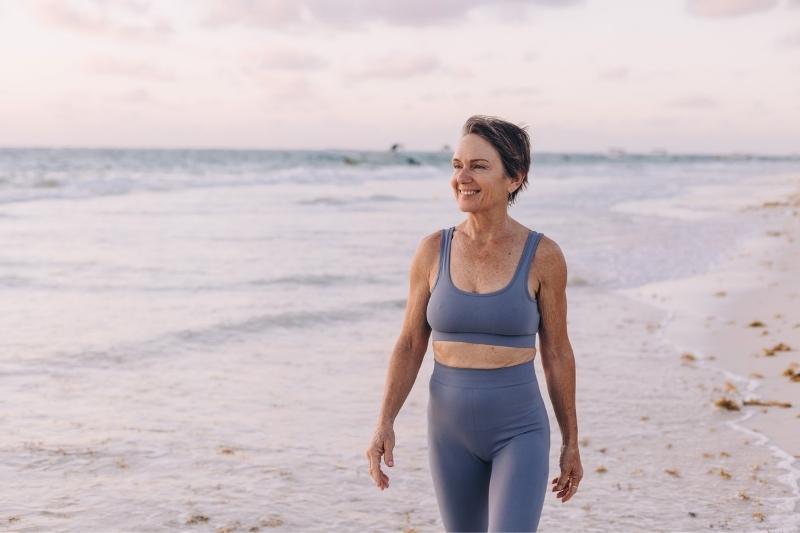Any effort to lose weight and, indeed, to maintain a healthy lifestyle must include exercise. But there’s a relatively simpler opportunity if you don’t want to spend time at the fitness center for hours on end. You can employ walking for weight loss results.
In the end, calories in and out determine how much weight is lost. This indicates that you must create a caloric deficit or expend more calories than you intake.
Any physical activity you do during the day can increase your calorie burn. Although walking is considered a low-intensity exercise, it’s nevertheless a valid strategy to promote weight loss compared to higher-intensity exercises like sprinting or jogging.
Additionally, it’s a fantastic choice for individuals who are merely beginning out and for deconditioned, inactive, or obese.
The Health Benefits of Walking
There are numerous methods in which walking promotes weight loss.
1. Calories Are Burned While Walking
First, it must be emphasized that walking isn’t the quickest weight loss method. However, a prolonged period of muscle activity will result in significant calorie expenditure. For example, walking an hour a day for a month results in little weight loss.
2. The Body Metabolism Is Boosted by Walking
Walking on a regular schedule helps to boost metabolic activity. The body will gradually speed up its metabolism as it becomes accustomed to this greater level of exercise.
Additionally, a higher metabolism level aids in burning more calories and inactive fat, ultimately increasing weight reduction.
3. Walking Works Out the Entire Body
For instance, walking affects the muscles in your back, arms, abs, and legs.
- Next, walking strengthens your legs, glutes, calve,s and thighs.
- In addition, walking aids in muscle development, particularly if you walk quickly.
- During walking, the abdominal muscles must work particularly hard to maintain balance.

- The heart muscles must pump blood to deliver oxygen to your cells. Walking, as a result, helps to strengthen them.
- Typically, a person swings their arms during the initial hundred steps. Consequently, the rear and upper body both get exercise.
Can Walking Alone Aid in Weight Loss?
Studies show that a regular walking regimen can help you lose a few additional pounds. But to lose weight, increased exercise should ideally be combined with better eating practices.
Additionally, start your walking regimen with reasonable goals. It won’t give you a six-pack or a ripped body, but it can help you become more physically fit overall.
How Far Should I Walk to Lose Weight?
Walking, according to the Centers for Disease Control and Prevention (CDC), helps our bodies get rid of more calories.
So, how much should I walk to lose weight? Maintaining a moderate pace while walking burns 280 calories every hour for someone around 154 pounds.
Does walking an hour a day help lose weight? You need to walk at least half an hour for no less than five days a week at a moderate pace to lose weight. But for better results, increase the speed and time you spend on your daily walks.
Getting Started with Walking
When beginning a walking regimen, keep the following in mind:
Before starting a walking program, educate yourself on what’s required. This could entail seeking medical advice, making purchases of essential walking supplies, including shoes and clothing, and more.

Next, you’ll master the optimal walking technique, emphasizing healthy posture and leg and arm movements.
To increase your walking time to between 30 and 60 minutes each day, figure out how often, how quickly, in which directions, and how far you should walk.
Do I Need Any Special Equipment to Begin a Walking Program?
One of its best features is that you nearly never need any specialist equipment to start walking for fitness. Walking only needs a decent pair of footwear that you might already own.
Sometimes people realize that while they advance, utilizing a smart gadget, such as a watch or smartphone, or a pedometer may enable them to record how much workout they’re achieving each day.
Suppose you struggle to stick to a walking schedule, keep a log of your daily steps. There isn’t anything else you need besides footwear, a pedometer, and possibly a good headphone set with your choice of music or audiobooks.
8 Walking Tips
Although walking may not be the most challenging exercise and may not work if your goal is losing a lot of weight instantly, it’s an efficient approach. So, how does walking help you lose weight?
By incorporating half an hour of brisk walking into the everyday routine, you could burn an additional 150 calories per day. The further and faster you walk, the more calories you’ll burn. While you can’t lose fat in specific areas, walking can help you lose fat in general.
Keep the following tips in mind:
#1 – Do It for Your Mental Well-Being
Walking enhances your emotional stability while simultaneously providing the physical advantages of exercise.
Regular walking aids in reducing the symptoms of long-term mental health issues like nervousness, depression, and anxiety.

Because it improves the flow of blood and its circulation to the brain and the body, it aids in mood enhancement.
Your hypothalamic-pituitary-adrenal (HPA) axis, a component of your central nerve response system, is positively impacted by it.
This is advantageous since the HPA axis controls your stress response. You could feel less worried if you walk for exercise since it helps to relax your nerves.
#2 – Take Walks to Discover Your Surroundings
You’ll notice that you never truly walk the same path twice if you pay attention to everything around you. There are constantly new sights to take in.
To keep your daily walk interesting, we suggest:
- Choosing various routes to avoid getting weary of taking in the same scenery
- Discover your surroundings by observing the landscape, the people, and the sounds
#3 – Concentrate on Developing a Habit
Make walking part of your routine by partaking in a stroll at the same time every day, for instance. You can invite a friend or partner to help you be accountable and get committed to your walking routine.
Additionally, downloading an app to log in to your daily walking activity or keeping a physical walking journal may help you develop walking as a habit.
#4 – Connect With Others on Your Strolls
Every stroll does have the possibility of blossoming into a fun gathering. Additionally, you’re less inclined to cancel when someone has intended to devote time to you.

You may try setting up a consistent walk date with a companion, biweekly, weekly, daily, or whenever it suits you.
#5 – Make No Excuses for Yourself
Do you genuinely want to get healthier and permanently lose weight? Then stop citing reasons not to, and just do it. Of course, it’s simpler to say than to do.
To flourish, you must be in the appropriate mindset to succeed. So, dress appropriately for rain, cold, or hot weather. You’ll be better equipped and less likely to skip a walk session if you do this.
#6 – Get Comfortable, High-Quality Shoes
Go for shoes that are flexible and supportive yet also comfort your feet. Select footwear featuring “breathable” uppers, like mesh made of nylon. Additionally, wearing bright clothing and a luminous vest will make you more visible to cars.
#8 – Walk Safe
The list below is some safety advice for walkers:
- When possible, take the walkways. Always keep your back to incoming cars when crossing roadways.
- If you are being attacked, shout “FIRE!” rather than “Help.” If people hear “FIRE!” they’ll react to you more quickly.
- Let someone know where you’re going and when you plan to return, and give them an approximate time and location.
- Avoid going outside after dark. Should you decide to, stick to well-lit routes. Carry a phone, a flashlight, whistle, and wear light-colored, reflective clothing.
Turn your Walking Into A Calorie-Burning Workout FAQs
Can You Lose Weight by Just Walking?
Yes. Walking stimulates weight loss, particularly with a low-calorie diet.

Make sure to read more on proper diet to pair with your walking regimen to answer questions like whether are sardines good for weight loss or oatmilk good for weight loss and any other diet-related queries.
How Long Does It Take To Notice Weight Loss From Walking?
The rate you lose weight is determined by various factors, such as your walking speed, length of time, severity, and frequency. Your weight and diet also impact your ability to lose weight.
Walking fast through steep areas multiple days per week while adhering to a low-calorie diet, for example, will produce faster results than walking briskly on flat terrain once per week.
Conclusion
For managing your weight, walking is a fantastic exercise option that you can perform practically anywhere. You only need to formulate attainable goals at the beginning of your weight loss journey to ensure you’re always motivated.
Start slow with regular walks of 10 minutes and gradually increase as you gain momentum.
The goal is to increase the frequency with which you walk and the total number of miles or moves completed daily. Try increasing the intensity several days weekly with accelerated walks or steeper inclines.
Also, consider consulting a healthcare professional before starting your new walking program. They can aid you in deciding a regimen that’s best for you.

I’m a triathlete and life coach, with a focus on holistic health, fitness & women’s issues.
I also write about my gastronomic adventures and my love for the outdoors.

